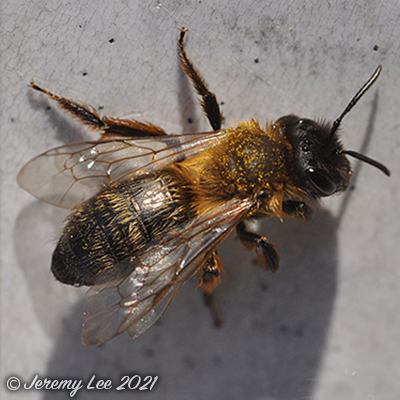
 |
|
Scientific Classifications explained » Amphibians » Ants » Aphids » Bees » Beetles » Birds » Bugs » Butterflies » Caterpillars » Damselflies » Dragonflies » Earwigs » Flies » Frog/Leafhoppers » Fungi » Galls » Grasshoppers » Harvestmen » Hoverflies » Lacewings » Ladybirds » Leaf Mines » Lichens » Mammals » Millipedes » Mosses » Moths » Sawflies » Slugs » Snails » Spiders » Trees » Wasps » Wild Flowers » Woodlice |
UK Nature > Bees > Andrena nigroaenea

Scientific Name: Andrena nigroaenea Common Name: Mining Bee Andrena nigroaenea is a solitary mining bee with an early flight period in spring and early summer. A conspicuously hairy, medium to large solitary bee, the thorax and the abdomen are covered in brown hairs. The brown hairs also extend down the hind legs. There is a patch of black hairs at the tip of the abdomen. The head is black and relatively hairless. This bee has been recorded from a variety of habitats including coastal undercliffs, dunes and other sandy places, parks and even large gardens. Areas of bare, well-drained soils close to flower-rich habitats should be searched for aggregations of nests. This is where the adults will be most active. Foraging bees will be seen on flowers but only in warm and sunny weather. The Early Spider Orchid (Ophris sphegodes) produces a pheremone to attract male Andrena nigroaenea for pollination. |
|

https://www.uknature.co.uk is a website dedicated to showing the immense diversity of UK nature and wildlife. Our vast range of habitats, from lowland arable to snow covered mountains, from storm-ravaged coastlines to peaceful inland freshwater lakes and rivers, from dry, sandy heaths to deciduous and coniferous forests, all these habitats contribute to the abundance of UK nature. We have wild birds in huge numbers either residing or visiting our shores (597 recorded species as at July 2013) and we must also not forget the humble back garden with its grass lawns, flower beds filled with nectar rich flowers, shrubs and trees, all designed to attract huge numbers of insects such as bees, moths, butterflies and hoverflies; and finally the small ponds which provide safe havens for frogs, toads, newts and even slow worms and grass snakes. www.uknature.co.uk is the showcase for my personal passion, photographing uknature in all its glory. I sincerely hope you all enjoy the fruits of my labours. This site and all images contained therein is © Jeremy Lee 2004 - 2021. All Rights Reserved. Site design by Jeremy Lee. Site development & IT Support by Stuart Lee. |